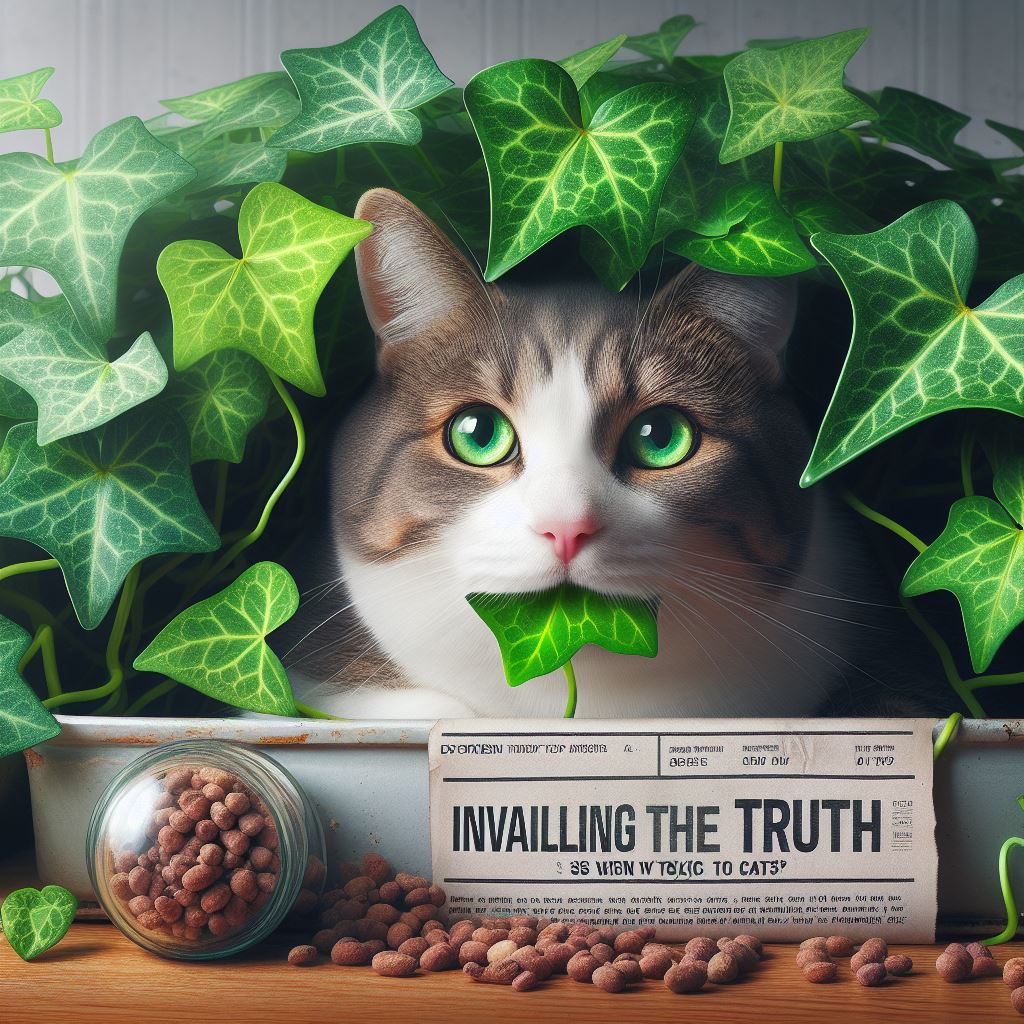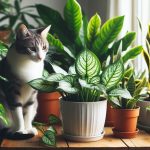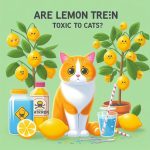Swedish Ivy, also known as Plectranthus australis, is a popular houseplant cherished for its cascading foliage and easy-care nature. However, pet owners often wonder, “Is Swedish Ivy toxic to cats?” Understanding the potential dangers of this plant is crucial for creating a safe environment for our feline companions. In this comprehensive guide, we will delve into the origins of Swedish Ivy, explore the toxic substances it may contain, and learn how to identify and address any potential risks to our beloved cats. Let’s unfold the truth about Swedish Ivy and its impact on our furry friends.
The Origin and Characteristics of Swedish Ivy
Swedish Ivy, also known as Plectranthus australis, is a popular trailing houseplant valued for its ornamental appeal and ease of care. Here are some key characteristics and origin of Swedish Ivy:
- Origin: Contrary to its name, Swedish Ivy did not originate from Sweden. It is a native to Southern Africa, specifically in areas like Zimbabwe, South Africa, and Swaziland.
- Appearance: The plant features lush, glossy green leaves with scalloped edges, which grow on trailing stems, making it a favorite for hanging baskets or as ground cover.
- Growing Habit: Swedish Ivy is a resilient and fast-growing plant, capable of thriving in both indoor and outdoor settings, provided that it receives adequate light and water.
- Toxicity: While Swedish Ivy is not considered highly toxic to humans or pets, it can still pose a threat to cats if ingested in large amounts. The plant contains essential oils that may cause mild gastrointestinal upset in felines.
In the next sections, we will delve deeper into the potential risks of Swedish Ivy to cats and how pet owners can ensure the safety of their beloved feline companions. Keep reading to discover the truth behind the question, “Is Swedish Ivy Toxic to Cats?”
Identifying Toxic Substances in Swedish Ivy
Swedish Ivy, also known as Plectranthus australis, is a popular houseplant with distinctive fleshy leaves and a trailing growth habit. While this ornamental plant is cherished for its low maintenance and aesthetic appeal, it’s essential for cat owners to be aware of its potential toxicity to their feline companions.

When it comes to understanding if Swedish Ivy is toxic to cats, it’s important to identify the specific substances within the plant that can pose a risk to feline health. The toxicity of Swedish Ivy to cats can be attributed to the presence of certain compounds, including:
Terpenoids: Swedish Ivy contains essential oils and terpenoid compounds that can be toxic to cats if ingested in large quantities.
Saponins: These natural detergents found in Swedish Ivy can cause gastrointestinal disturbances and may be harmful if consumed by cats.
Phenolics: Swedish Ivy may contain phenolic compounds, which can be toxic to cats and lead to symptoms of poisoning if ingested.
It’s important to note that while these substances are present in Swedish Ivy, the degree of toxicity can vary depending on factors such as the cat’s size, the amount ingested, and the cat’s individual sensitivity. As such, cat owners should remain cautious and informed about the potential hazards associated with this plant.
By being aware of the specific toxic substances present in Swedish Ivy, cat owners can better understand the risks and take appropriate measures to ensure their pets’ safety. Remember that prevention and education are crucial in safeguarding cats from potential plant-related hazards.
Make sure to keep an eye out for the next blog post section, where we will delve into the specific dangers of Swedish Ivy toxicity in cats and the symptoms to watch out for.
Understanding the Dangers of Poisoning in Cats
When it comes to the question “is Swedish ivy toxic to cats,” understanding the potential dangers of poisoning in cats is crucial. Swedish ivy, scientifically known as Plectranthus verticillatus, contains substances that can be harmful to cats if ingested. It’s essential for cat owners to be aware of the following points:

Toxic Compounds: Swedish ivy contains chemical compounds such as saponins and essential oils. These substances can cause gastrointestinal distress and other health issues in cats if they consume the plant.
Impact on Cats: When cats ingest Swedish ivy, they may experience symptoms such as vomiting, diarrhea, lethargy, and incoordination. In severe cases, it can lead to more serious complications, affecting vital organs and leading to potential long-term health concerns.
Risk of Exposure: Cats can come into contact with Swedish ivy in both indoor and outdoor settings. Whether the plant is potted indoors or growing in gardens, there’s a risk of cats being exposed to it, especially if they have a habit of exploring and nibbling on plants.
Unintentional Ingestion: Cats may accidentally ingest Swedish ivy while grooming or playing near the plant, making it essential for pet owners to recognize the potential risks and take preventive measures.
Understanding the dangers of poisoning in cats due to Swedish ivy consumption highlights the importance of being proactive in safeguarding feline companions from potential plant-related hazards. By remaining informed about the risks and taking appropriate precautions, cat owners can create a safer environment for their beloved pets.
Symptoms of Swedish Ivy Toxicity in Cats
When it comes to the question “is Swedish ivy toxic to cats,” it’s crucial to be aware of the potential symptoms of toxicity. If you suspect that your feline friend has come into contact with or ingested Swedish Ivy, it is vital to watch out for the following signs of poisoning:

Vomiting and Diarrhea: Cats may exhibit frequent vomiting and diarrhea after ingesting Swedish Ivy. This can lead to dehydration and discomfort for the cat.
Loss of Appetite: A decrease in appetite or reluctance to eat may be a sign of Swedish Ivy toxicity in cats.
Lethargy: Cats may appear unusually tired, weak, and uninterested in their surroundings when affected by toxicity from Swedish Ivy.
Drooling and Pawing at the Mouth: Excessive drooling or pawing at the mouth can be indicative of oral irritation caused by exposure to toxic substances in Swedish Ivy.
Difficulty Breathing: In severe cases, cats may experience difficulty breathing or coughing as a result of respiratory irritation.
Monitoring your cat for these symptoms and seeking immediate veterinary attention if you notice any of them is crucial to ensure the well-being of your pet. Early detection and prompt intervention can significantly improve the prognosis for cats affected by Swedish Ivy toxicity.
It’s important to remember that while Swedish Ivy is a common household plant, it can pose a risk to the health of your feline companions. Taking proactive measures to prevent exposure to toxic plants is essential for ensuring the safety and health of your pets.
Immediate Actions to Take if a Cat Ingests Swedish Ivy
If you suspect that your cat has ingested Swedish Ivy and is showing signs of toxicity, it is crucial to take immediate action to ensure your pet’s well-being. Here are the steps to follow:

Remove Access to the Plant: Quickly remove any remaining Swedish Ivy from your cat’s vicinity to prevent further ingestion.
Contact a Veterinarian: Immediately contact your veterinarian or a pet poison helpline for guidance. Inform them about the situation and follow their recommendations carefully.
Monitor Your Cat: Keep a close eye on your cat and observe for any unusual symptoms or behavior changes. Note down any specific details such as the time of ingestion and the quantity consumed.
Do Not Induce Vomiting: Refrain from attempting to induce vomiting in your cat unless advised to do so by a veterinary professional. Some substances can cause more harm if regurgitated.
Bring Samples: If possible, bring a sample of the plant or any remaining parts that your cat may have drooled or vomited to the veterinarian to assist in identification and treatment.
It is crucial to act swiftly and decisively. Even if your cat appears to be unaffected, prompt action can minimize potential harm. Remember, always prioritize your pet’s safety and well-being by seeking professional veterinary assistance without delay.
Remember, the focus keyword “is Swedish Ivy Toxic to Cats” should be naturally incorporated into the text and not overused.
Seeking Veterinary Assistance for Swedish Ivy Poisoning
If you suspect that your cat has ingested Swedish Ivy and may be experiencing toxicity, it is crucial to seek veterinary assistance immediately. When it comes to potential plant poisonings, especially with a question like “is Swedish ivy toxic to cats,” early intervention is key to preventing severe health issues. Here’s what you need to consider and do when seeking veterinary assistance:

Contact Your Veterinarian: Without delay, reach out to your veterinarian or the nearest animal poison control center. Provide them with details about the situation, including the plant involved and your cat’s symptoms.
Observe and Note Symptoms: Keep a close eye on your cat’s behavior and any physical symptoms. Note down the time of ingestion, changes in behavior, and any physical manifestations of illness. Providing this information to the vet can aid in prompt and accurate diagnosis.
Follow Professional Guidance: Your veterinarian or animal poison control expert will provide specific instructions tailored to your cat’s condition. This may include guidance on inducing vomiting (if the ingestion was recent), bringing your cat in for an immediate examination, or any necessary first-aid measures.
Avoid Home Remedies: Refrain from administering any home remedies or medications without professional approval. Certain actions, such as inducing vomiting, may exacerbate the situation depending on the substance ingested and the time elapsed since ingestion.
Remember, swift action and professional guidance are critical in cases of potential toxicity. By promptly seeking veterinary assistance, you can ensure the best possible care for your feline friend in the event of Swedish Ivy poisoning.
Treatment Options for Swedish Ivy Toxicity in Cats
When it comes to treating Swedish Ivy toxicity in cats, prompt action is crucial. Here are the treatment options available:

Inducing Vomiting: If ingestion has occurred within the last two hours, your veterinarian may induce vomiting to remove the plant material from the cat’s system. However, this method is not always recommended, especially if the cat is already showing signs of distress.
Activated Charcoal: This can be administered to absorb the toxins and prevent them from being absorbed into the cat’s bloodstream. It is most effective if given within 30 minutes to a few hours of ingestion.
Fluid Therapy: If the cat is dehydrated or experiencing vomiting or diarrhea, the vet may administer fluids to restore hydration and flush out the toxins.
Medication: In severe cases, the cat may require medication to manage symptoms such as seizures, tremors, or irregular heartbeats.
It’s important to note that there is no antidote for Swedish Ivy toxicity. Treatment focuses on managing symptoms and supporting the cat’s recovery. Always seek professional veterinary help if you suspect your cat has ingested Swedish Ivy, as they will tailor the treatment to your cat’s specific condition and needs.
In comparison to treatment, prevention is always the best option. After seeking treatment for Swedish Ivy toxicity, consider cat-safe houseplants as an alternative to Swedish Ivy to avoid any future incidents.
Preventive Measures to Protect Cats from Toxic Plants
When it comes to ensuring the safety and well-being of our feline friends, preventing exposure to toxic plants is essential. Here are some preventive measures to protect cats from toxic plants such as Swedish Ivy:

Knowledge is Key: Educate yourself about the plants that are potentially toxic to cats, including Swedish Ivy. Awareness is the first line of defense in keeping your home environment safe for your pets.
Placement and Accessibility: Place toxic plants out of reach of your cats. Consider hanging planters, shelves, or designated areas that are inaccessible to curious felines.
Choose Cat-Safe Alternatives: Opt for cat-friendly plants instead of toxic ones. There are numerous non-toxic plant options that can add greenery to your home without posing a risk to your pets.
Vet Check: Before introducing a new plant into your home, consult with your veterinarian to ensure its safety for your cats. Your vet can provide guidance on cat-friendly greenery options.
Regular Monitoring: Keep an eye on your cats’ behavior around plants. If you notice excessive interest or attempts to nibble on foliage, it may be time to reconsider the plant’s placement or remove it altogether.
Labeling: Consider labeling your indoor plants to ensure that anyone caring for your cats is aware of any potential hazards.
By implementing these preventive measures, you can create a safe and pet-friendly environment, minimizing the risk of Swedish Ivy or any other toxic plants causing harm to your beloved feline companions.
Alternatives to Swedish Ivy for Cat-Safe Houseplants
When it comes to choosing houseplants that are safe for your feline friends, there are several alternatives to Swedish Ivy that can brighten up your home without posing a threat to your beloved pets. Here are some cat-safe houseplants to consider:
Spider Plant (Chlorophytum comosum): This popular choice is easy to care for and safe for cats. Its long, cascading leaves are visually appealing, and it can thrive in various conditions, making it an ideal addition to any home.
Boston Fern (Nephrolepis exaltata): Known for its feathery fronds, the Boston Fern is non-toxic to cats and adds a touch of elegance to indoor spaces. It thrives in high humidity and indirect light, making it perfect for bathrooms or kitchens.
Areca Palm (Dypsis lutescens): This palm variety is a safe option for pet owners, as it is non-toxic to cats. The Areca Palm not only looks stunning but also serves as a natural air purifier, enhancing the overall air quality in your home.
Calathea (Peacock Plant): With its striking patterns and vibrant colors, the Calathea is a beautiful cat-safe houseplant option. This low-light plant adds a pop of color to any room and is safe for cats.
By opting for these cat-safe alternatives, you can create a green and pet-friendly environment in your home, providing both you and your feline companions with a safe and harmonious living space.
Remember to always research any houseplant thoroughly before bringing it into your home, to ensure it is indeed non-toxic to cats.
Educating Pet Owners on Plant Safety for Cats
As responsible pet owners, it is crucial to prioritize the safety of our feline companions by understanding and implementing measures to prevent exposure to toxic plants like Swedish Ivy. Educating oneself and other pet owners on plant safety for cats can significantly reduce the risk of plant-related poisoning incidents. Here are essential points to consider when educating pet owners on plant safety for cats:

Identification: Teach pet owners how to identify toxic plants commonly found in households. Highlight the distinct characteristics of Swedish Ivy and other dangerous plants to facilitate easy recognition.
Placement: Emphasize the significance of placing toxic plants out of the reach of cats. Recommend elevated shelves or hanging baskets to deter cats from accessing these plants.
Alternative Safe Plants: Provide a list of cat-safe houseplants as alternatives to Swedish Ivy. Suggest popular options like Spider Plant, Boston Fern, or Areca Palm that add greenery to the home without posing a risk to cats.
Awareness and Vigilance: Encourage pet owners to stay informed about the toxicity of common household plants. Regularly update them on the potential risks and symptoms of plant poisoning in cats.
Training and Resources: Offer educational materials, such as brochures or online resources, to help pet owners gain comprehensive knowledge about plant safety for cats.
By spreading awareness and providing practical guidance on plant safety for cats, pet owners can create a secure home environment that minimizes the risk of accidental ingestion of toxic plants like Swedish Ivy. This proactive approach is essential in safeguarding the well-being of beloved feline companions.
Frequently Asked Questions
Is Swedish Ivy toxic to cats?
Yes, Swedish Ivy is toxic to cats. If ingested, it can cause symptoms such as vomiting, diarrhea, and loss of appetite. It’s important to keep Swedish Ivy plants out of reach of cats to prevent accidental ingestion.
What are the symptoms of Swedish Ivy poisoning in cats?
The symptoms of Swedish Ivy poisoning in cats include vomiting, diarrhea, loss of appetite, and in severe cases, difficulty breathing and tremors. If you suspect your cat has ingested Swedish Ivy, seek veterinary care immediately.
How toxic is Swedish Ivy to cats?
Swedish Ivy is considered moderately toxic to cats. Ingestion can lead to gastrointestinal upset and other symptoms. It’s best to avoid keeping Swedish Ivy plants in homes with cats to prevent accidental poisoning.
Are there non-toxic alternatives to Swedish Ivy for cat-friendly homes?
Yes, there are many non-toxic plant options that are safe for homes with cats. Some examples include spider plants, Boston ferns, and African violets. Always research and verify the safety of plants before introducing them to your home if you have cats.
What should I do if my cat has ingested Swedish Ivy?
If you suspect that your cat has ingested Swedish Ivy or any other toxic plant, contact your veterinarian immediately. Be prepared to provide information about the plant, the amount eaten, and your cat’s symptoms. Quick action is essential when dealing with plant toxicity in cats.
Table: Swedish Ivy and their Potential Toxicity to Cats
| Swedish Ivy Variety | Scientific Name | Toxic Parts for Cats | Potential Symptoms in Cats |
|---|---|---|---|
| Swedish Ivy (Plectranthus) | Plectranthus australis | All parts | Oral irritation, vomiting, diarrhea, lethargy |
| Note: Ingestion or contact with any part of the Swedish Ivy plant may result in adverse effects in cats. |
Important Safety Tips:
- Secure Placement: Keep Swedish Ivy out of reach, placing it in areas inaccessible to cats.
- Regular Monitoring: Observe your cat for any signs of nibbling or ingesting the plant, and take prompt action if detected.
- Immediate Veterinary Care: If you suspect your cat has ingested Swedish Ivy and exhibits symptoms, seek immediate veterinary attention.
- Safe Alternatives: Explore cat-friendly plants like spider plants or catnip as alternatives to ensure a pet-safe environment.
Always prioritize the well-being of your feline companions by staying informed about potential hazards and taking preventive measures. If uncertain, consult with a veterinarian for personalized advice.
Insight into Feline Safety: Is Calathea Toxic to Cats?
Read More Now..






